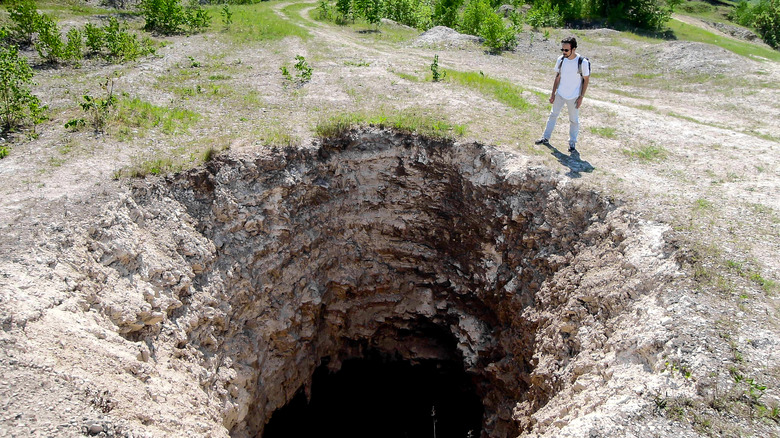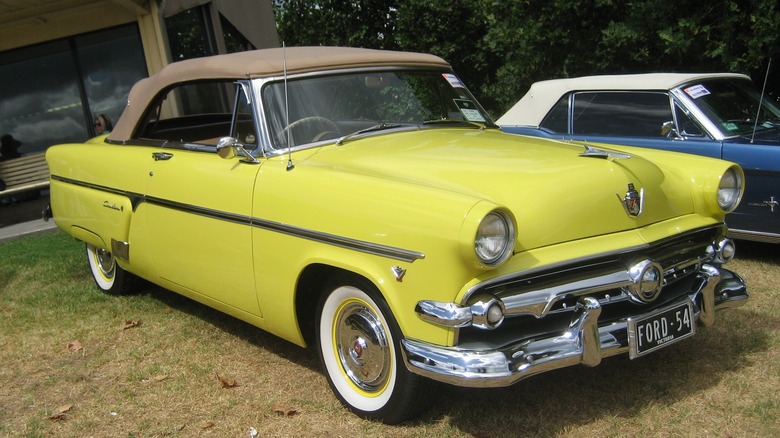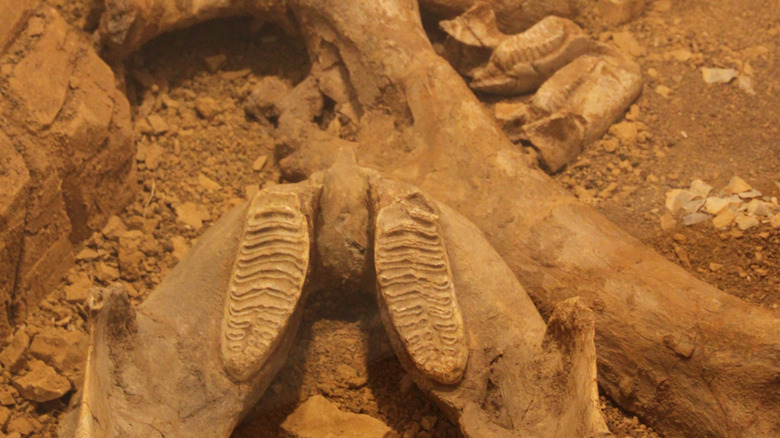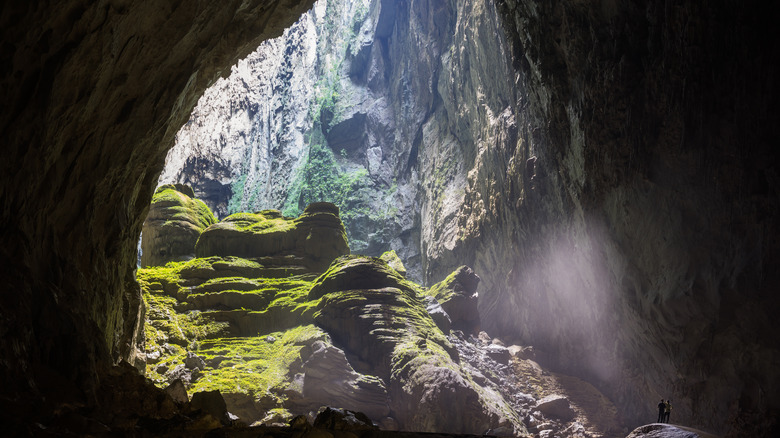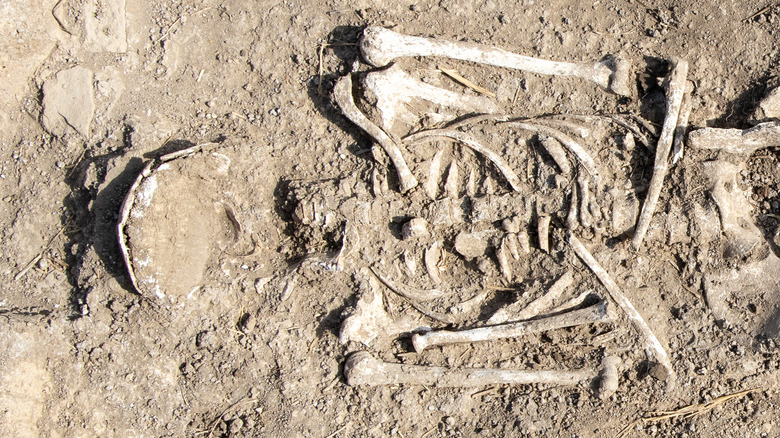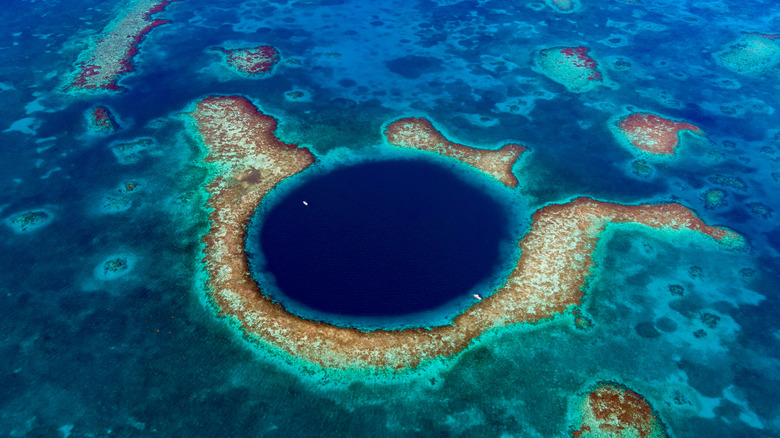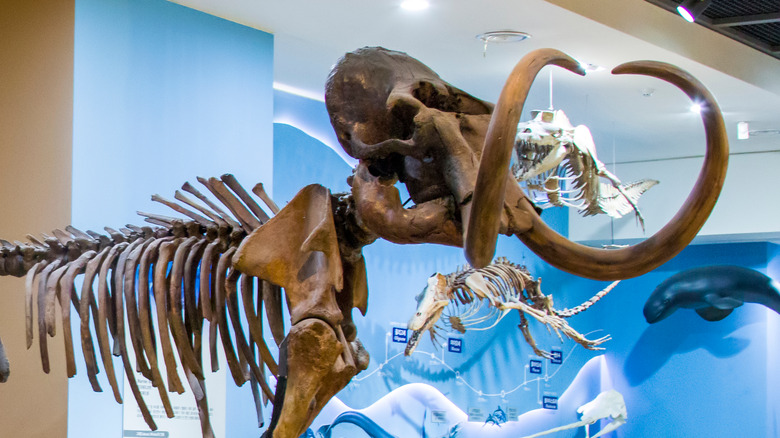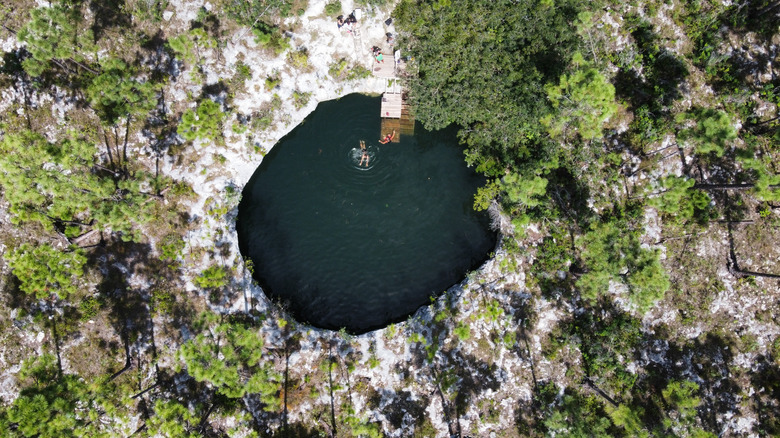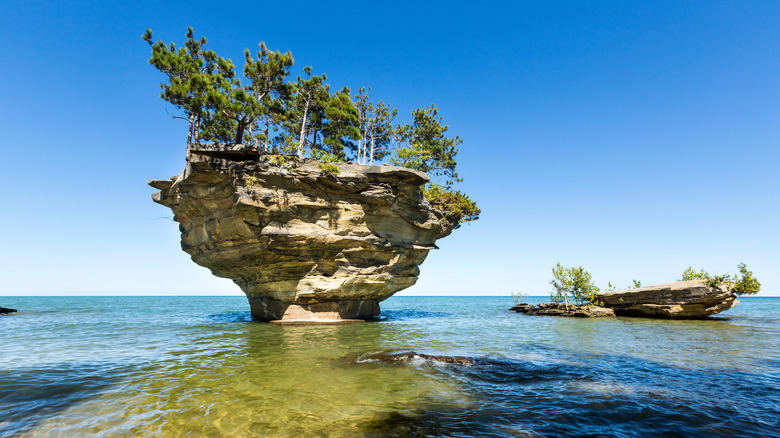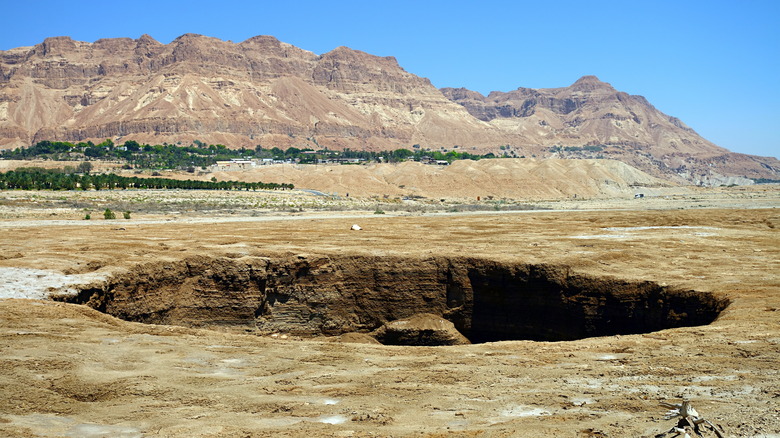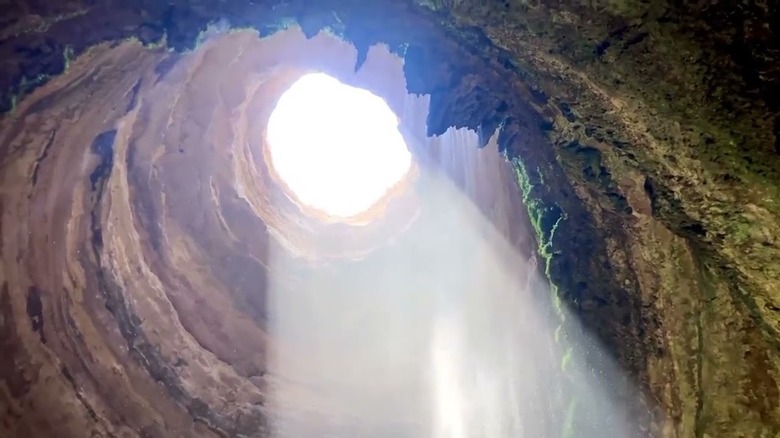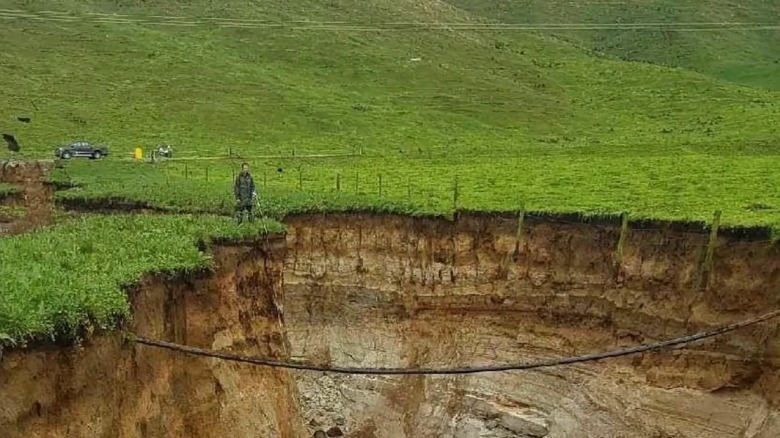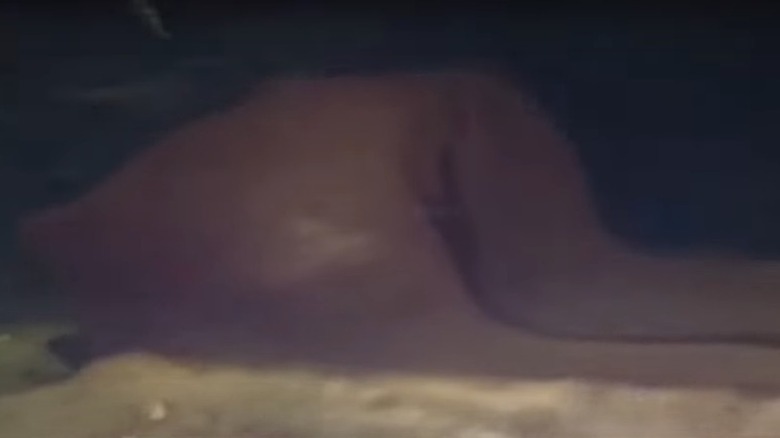The Most Incredible Things Discovered In Sinkholes
According to the United States Geological Survey, sinkholes are primarily caused by groundwater eroding the rock below the land surface, and they are particularly prevalent in areas where said rock is carbonate, salt bed, or limestone. They can develop over tens of thousands of years, then reveal themselves in dramatic fashion in mere seconds as the ground finally gives way.
But sinkholes are so much more than just a big hole in the ground. There are many forms sinkholes can take, they can be vastly different in size, and there's plenty of diversity in where they can be found on the planet — or under it and, in many cases, underwater. Not to mention the array of amazing things that can be found in sinkholes. Exploring a sinkhole can mean stepping back thousands or even millions of years to where ancient layers of the earth and age-old artifacts are exposed. Many sinkholes have also divulged more recent secrets, such as those found harboring manmade objects. Others have revealed previously unknown wonders of nature.
So while sinkholes can be deadly and damaging, they also often reveal wonders.
A Ford Crestline Sunliner
The Ford Motor Company produced a vehicle called the Ford Crestline for all of three model years. The first Crestlines rolled off the assembly line in 1952 and the last of the make was produced in 1954. As noted by Auto Evolution, it was hardly a high-performance vehicle, with a top speed of around 65 miles per hour and a laborious 18.5-second slog to reach that 60 MPH sweet spot. Only a few thousand of the vehicles were produced and, despite classic good looks, the car never gained the prized status many vintage vehicles do, so it was largely forgotten.
Then, according to reporting from the online auto-themed imprint Motorious, a sinkhole opened up in a South Dakota neighborhood in the spring of 2020. At first, it seemed like nothing but bad news. The sinkhole formed when the ground gave way above a gypsum mine last used about a hundred years earlier. On inspection, it became clear that dozens of homes in the Hideaway Hills neighborhood were at risk of collapsing and would likely have to be abandoned.
Adding an oddly amusing twist to the grim news, though, was the discovery of a rare Ford Crestline buried within the mine. The vehicle may have been washed into the mine by heavy rains at some point well over half a century ago, though for how long it has lurked beneath the earth, and to whom the car belonged, are mysteries for the ages.
14,500-year-old mastodon bones
In 2016, The Guardian reported that scientists exploring a flooded sinkhole in Florida made a series of discoveries that moved the beginning of human settlement back about 1,500 years. For decades, there was general consensus among archeologists, anthropologists, and paleontologists that humans had reached the Americas sometime late during the last Ice Age by way of a so-called "land bridge" exposed beneath what is now the Bering Sea. The generally accepted timeframe of the first human arrival in the Americas from Eurasia was some 13,000 years back.
But the bones, those of a mastodon clearly butchered by human hands as well as those of early dogs who evidently lived with or followed humans, as well as a number of handmade tools, have been dated to approximately 14,550 years of age. The scientists who discovered the ancient artifacts are confident that the bones, tools, and even some fossilized excrement constitute irrefutable evidence that humans had made their way not only to the Americas but all the way across the continent long before initially thought.
And in fact, findings like these throw into doubt more than just the timing of early human migration from one continent to another, but even merit some rethinking of the way our forebears reached North and South America. The theory of early migration via the water has gained much wider acceptance in recent years, per Smithsonian Magazine, and finds like the one in the sinkhole near Tallahassee, Florida only strengthen the case for earlier and perhaps alternative arrival.
The world's biggest cave
Imagine a cave so vast it is in effect a world unto itself. Except you don't have to imagine it, you can visit it, as such a place exists. It is a cave called Han Son Doong (or Mountain River Cave) located in Phong Nha Ke Bang National Park in central Vietnam, per Lonely Planet, and it's an underground space so vast it has its own ecosystem and even its own weather patterns. Were it not for this fascinating subterranean weather, in fact, Hang Son Doong might still be unknown to the world: it was only "discovered" in 1990, and not truly explored until 2009.
The cave's location was unearthed when a local man named Ho Khanh took shelter from a downpour under a cliff formed by rocks towering up from the surrounding jungle and noticed a hole in the earth out of which were emerging a cool breeze and wisps of cloudy mist. For nearly two decades, the mysterious sinkhole that seemed to breathe clouds was forgotten. Then, in 2009, Ho Khanh would lead a team of spelunkers to the spot, and there they would uncover a marvel that has since become a UNESCO World Heritage Site, with the United Nations noting the massive cave's "great importance for enhancing our understanding of the geologic, geomorphic, and geochronological history of the region." Within the cave system can be found unique flora and fauna, amazing geological structures, underground rivers, and an entire independent weather system, the source of those cloudy puffs that revealed the cave after it had lurked unknown for untold epochs.
13,000-year-old human settlements
You can thank discoveries made in yet another sinkhole for not only further establishing how long ago early humans reached the Americas, but also for adding a new and fascinating element to the ancient tale: apparently, more than one subspecies of ancient human arrived on the continents. According to findings reported in a scientific journal published by PLOS, skeletal remains found in an underwater sinkhole called the Chan Hol cave, located on the Yucatán Peninsula in the south of Mexico, prove that humans had reached latitudes that far down in the Americas by 13,000 years ago, meaning they either arrived in the north and began moving southward earlier than originally thought, or else they reached the Yucatán via a different route than the Bering Strait Land Bridge.
Either way, perhaps the most monumental evidence found in the sinkhole was that of what scientists call "mesocephalic cranial morphology," which is a very science-speak way to describe skull shape, one which was distinctly different than the "dolichocephalic morphology" for the known Paleoindians living in Central Mexico at the same time. To put that in layman's terms, there were groups of early humans with distinctly different characteristics living near each other at or nearly at the same time. As evolution takes a long time, it points to these groups having arrived via different routes and at different times, which creates more questions than it answers, but that's all just the fun of it for scientists and armchair enthusiasts alike.
Stalactites and stalagmites
The Great Blue Hole, located off the coast of Belize, belongs on the Bucket List of anyone who loves scuba diving, or who simply loves the ocean in general — after all, this magnificent natural formation looks great seen above the surface of the water. According to the local resort Chabil Mar, the Great Blue Hole, also known as the Belize Blue Hole, which is found 62 miles off the coast, is an underwater wonder. It's an impressive 984 feet in diameter at its widest point and is more than 350 feet deep.
All the more impressive is the fact that, for tens of thousands of years, this deep "hole" was entirely above the water and was in fact a dry cave. According to Business Insider, the cave was only filled with water some 14,000 years ago as glaciers melted and ice sheets retreated, causing sea levels to rise at the end of the last ice age. Thus, exploration of the interior of the Blue Hole reveals stunning geological formations that can only happen in the dry conditions of a cave: stalactites and stalagmites. Some are small, some are dozens of feet long.
Also found at the bottom of the Great Blue Hole are a surprising amount of dead sea creatures. About 285 feet below the sea's surface, divers detected a layer of hydrogen sulfide spanning the width of the hole, and below that toxic strata is water nearly devoid of dissolved oxygen. So any animal, like conchs or crabs, that slipped below the hydrogen sulfide would suffocate and die.
A groundbreaking mastodon fossil
So another find of mastodon bones in another sinkhole in the southern states of America, what's the big deal, right? After all, we know scientists have found mastodon bones in American sinkholes plenty of times before, so what's special about the specimen recovered from a sinkhole in Tennessee in 2016? According to reporting from Ars Technica, the mastodon remains found in the Gray Fossil Site, so named for being near Gray, TN, are not only remarkable for the completeness of the skeleton, but also because they seem to belong to a species not previously known to have lived in North America at the time.
The skeleton recovered at the Gray Fossil Site has a skull distinctly different than that of the aptly named American mastodon (or Mammut americanum), the most common ancient pachyderm of the area. It's entirely possible that the fossil found in the sinkhole represents a previously unknown species of ancient creature, but the confirmation may still be long in the offing as scientists work to re-assemble the full skeleton and piece together just what happened to the animal. Regardless of what they eventually learn about this specific animal, we know the sinkhole in which it perished is some five million years old, meaning mastodons had already been plodding about the planet for some 20 million years before it was created, based on data about mastodon life on earth sourced from the National Library of Medicine.
Revelations of the human toll on animal life
Exploration and analysis of a sinkhole in the Bahamas have once again confirmed what just about everyone already takes for granted: human beings are really bad for the planet. We're especially bad for the part of the planet that consists of animals unlucky enough to be alive at the same time we are, because our activities are very good at driving them to extinction. And in the case at issue here, humans managed to kill off myriad animal species even in preindustrial years, according to Live Science.
A team of scientists exploring the Sawmill Sink sinkhole on the island of Abaco in the Bahamas found evidence that nearly two dozen species of animals, including reptiles and birds, went extinct in a short period of time following human arrival on the islands about 1,000 years ago. And there's really no doubt it was human activity that did them in: these species survived through millennia in which the earth warmed and sea levels rose following the end of the last ice age. Though to be fair, many more species have been found to have died out in the Bahamas before humans showed up on the islands.
Along with remains of all the recently departed creatures found in Sawmill Sink, explorers have also found the bones of creatures who lived much farther back, including many animals who inhabited the cave that would become Sawmill Sink when it was still above ground and dry during the ice age. 1About 5,000 years ago, the island would have been 15 times larger than it is today, with sea levels being 300 some feet lower.
A colony of strange microorganisms
According to World Atlas, Lake Huron is the second largest of North America's famed Great Lakes, with an area of 23,000-plus square miles and with some 850 cubic miles of water in total. It is more than 200 miles across at its widest point and 750 feet deep at its deepest. In other words, this is a very large lake. Ironic, then, that some of the most fascinating things ever found in Lake Huron are so small you can't see them with the naked eye.
Regional interest publication US-23 Heritage Route relates how a sinkhole beneath Lake Huron has been found to be the home of some surprising creatures. In the Middle Island Sinkhole, scientists have found groundwater vents that emit high concentrations of sulfates and around which dissolved oxygen is scarce. But rather than this creating barren, lifeless underwater areas as one might expect, instead, life thrives around the vents, just not life as you might expect. Sinkholes including and similar to the Middle Island Sinkhole are heavily colonized by single-celled microorganisms like bacteria and archaea, a type of prokaryote, according to Britannica.
And in shallower areas of the Great Lakes, where sunlight easily penetrates to the lakebed, other organisms hold sway, such as photosynthetic cyanobacteria that create vibrant purple layers covering much of the surface down beneath the waters.
A new species of early human (maybe)
If you like to think of the progress of human evolution as neat and tidy, as a series of linear steps leading from early, ape-like hominids to ever more adept and adaptable bipeds to toolmaking masterminds to us, then you might not want to explore the depths of a certain sinkhole in the Israeli desert. The sinkhole in question is near the city of Ramla, which is itself a pretty ancient spot, having been founded about 1,300 years ago. In said sinkhole, according to reporting from Archeology, scientists found some ancient remains of early hominids that are truly mysterious. The fossils recovered in the Qesem, Zuttiyeh, and Tabun caves may well be those of a previously unknown species of early human, which has been dubbed the Nesher Ramla Homo type for now.
Carbon dating finds the bone fragments, which were from a skull and jaw, are between 140,000 and 120,000 years old, which places them as overlapping with the Neanderthals for many thousands of years, per the Natural History Museum of London. It's even possible that Nesher Ramla Homo interbred with Neanderthals or even with Neanderthal ancestors, influencing the family tree that would go on to contribute a bit of genetic material to modern humans with European or Asian ancestry. Also found beneath the Israeli desert along with the fossil remains were many fragments of stone tools and animal bones, many showing signs of butchery, so we know these ancient hominids were clever and capable.
Unique geology and reptiles
The Well of Barhout, also known as the Well of Hell, has long been a no-go spot for locals living in Yemen's al-Mahra province, an eastern region near the border with Oman. But according to Live Science, when a group of intrepid explorers finally did descend down into the depths of this very deep sinkhole, they did not find themselves in hell after all. There were lots of snakes, though.
Long rumored to be a gateway to the underworld, this desert sinkhole, which measures just under 100 feet across, was also said to be the lair of malevolent genies and other spirits. Scarce few facts were known about the geological structure until just last year when several cavers with the Omani Caves Exploration Team (OCET) descended all the way to the floor of the Well, which turned out to be an impressive 367 feet below the surface of the desert.
Down in the Well of Hell, the cavers many dead animals who had apparently made their way into the Well never to escape it, many living snakes, via Penn Live – though don't start picturing a slithering snake pit, Indiana Jones-style — and some frogs, along with beautiful natural formations like stalactites and cave pearls, which are "small, almost spherical concretion of calcite that is formed in a pool of water in a cave," according to Britannica. The sinkhole is likely millions of years old, and as far as we know, had never before been explored by humans. The exact nature of its creation is not yet known but may be revealed with more exploration.
A 60,000-year-old volcano
If you think you're having a bad day, well, we're sorry to hear that, but at least be glad you're not having a day like a farmer named Gabriel Lafalla had one day in the spring of 2018. On that May morning, a massive sinkhole opened up near him that, had he been riding his bicycle a few feet to the right, could well have meant his death, according to the online magazine Stuff. The massive sinkhole, which opened up on an already ominously named patch of land called Earthquake Flat, located near the city of Rotorua in New Zealand, was created when heavy rains unsettled the earth above rock hollowed out by an ancient volcano.
The area was inundated with the heaviest rains in its recorded history in the days leading up to the sinkhole's sudden formation, and as you know by now, lots of water and open spaces under the ground are the perfect recipe for a sinkhole to form. Unlike many sinkholes that are surprisingly round and uniform in shape, at least as viewed from their openings, this massive though not very deep sinkhole was almost more of a sink valley. It opened up in the shape of a long, jagged canyon around which the farmworkers then had to navigate and into which scientists were happy to plunge to study layers of exposed rock.
An ancient Mayan canoe
In 2021, a crew working to install a railroad that would bring tourists to an ancient Mayan site on the Yucatán Peninsula ironically found an ancient Mayan artifact that was every bit as interesting as the ruins they were making more accessible. According to reporting in Cosmos Magazine, the railroad workers came across a Mayan canoe resting at the bottom of a water-filled sinkhole — also called a "cenote" locally — where it had evidently been hiding out for centuries. The canoe, which is a little more than five feet long and about two and a half feet wide, according to The Guardian, is likely from sometime between the years 830 and 950 CE, which puts it near the height of the Mayan culture's existence.
The ancient artifact was discovered purely by good luck, one of the workers on the Maya Train spotted it while taking a dip in the sinkhole while on a break. The region has also uncovered artifacts such as pottery shards, paintings on cave walls, and what are knives apparently used in rituals, all of which has led experts to assume the area held special spiritual significance for the ancient Maya. The canoe itself may have been used to transport holy objects or in the execution of rituals, or it may have served a more banal purpose, perhaps having been used to transport water from the freshwater sinkholes to ancient Mayans living nearby.
